The owner of the local Indian restaurant knows my name. And my order. He throws in a couple of samosas “just this once” (this is the third time). What makes me loyal to this particular spot—besides the amazing food—is this personalized experience. We are mutually rewarded by my repeat business.
Knowing your customers by name is, of course, Mom-and-Pop 101. Retailers have long understood that drawing customers to brick-and-mortar stores meansoffering an experience they can’t get online: taste, touch, smell, sound, a sales associate that says “Welcome back, Dayna” and guides a hot tea into your hands.
As an online store owner, you might not know your customers by face, but you have the potential to learn a lot more about them.
But online-only brands are also recognizing the appetite for personalized shopping experiences. Shopify surveyed buyers leading up to Black Friday and found that 59% said they welcomed personalized product recommendations. Brands targeting millennials have an even bigger potential—that number jumps to 78% within this segment.
In the midst of a global pandemic that has all but erased face-to-face experiences, there’s no better time to assess your own business’ personalization efforts. Many brick-and-mortar businesses have diverted focus to their online stores, orlaunched a website for the first time. If this is you, read on. You can recreate the magic of visiting your store in person with a few simple tools. For more help on adapting to COVID-19’s impact on your business,click here.
As an online store owner, you might not know your customers by face, but you have the potential to learn a lot more about them. Click-based data really only scratches the surface. And that information can help inform product development and marketing campaigns, improve loyalty and customer happiness, and reduce returns. We spoke to several store owners to understand how they’re using quizzes, concierge services, and other personalized experiences to achieve these goals.
Table of Contents
⚡Bonus:Read to the bottom of this article to take our quiz and discover the best tools for你的store based on your business goals and unique challenges.
1. Fit: beyond the size chart
Apparel brands have the biggest opportunity for personalized experiences. A 2019reportindicates that purchasing the wrong color, size, or fit is the top reason for returns (46%). Getting fit right is essential for brands in minimizing returns.
Though the frequently misquoted stat that 80% of women wear the wrong bra size doesn’t have muchscientific backing, the spirit of it rings true: finding the right bra for your body is hard. I had been wearing the “wrong size” for 20 years. That’s according to a teenaged sales associate at Victoria’s Secret. And while she was right that 32C definitely felt better than my 34A, it’s not an exact science. All bras—like all breasts—are not created equal. The solution, at least for me, has been hours I’ll never get back wrestling with clasps under stark fitting room lighting.
Yet, brands like胡椒andAnaOnohave successfully removed this unpleasant step—these niche bra stores (for small breasts and post-op breasts, respectively) operate almost exclusively online. Fit quizzes have helped these brands make more accurate size recommendations for their customers by asking about body shape and needs rather than just band measurements.

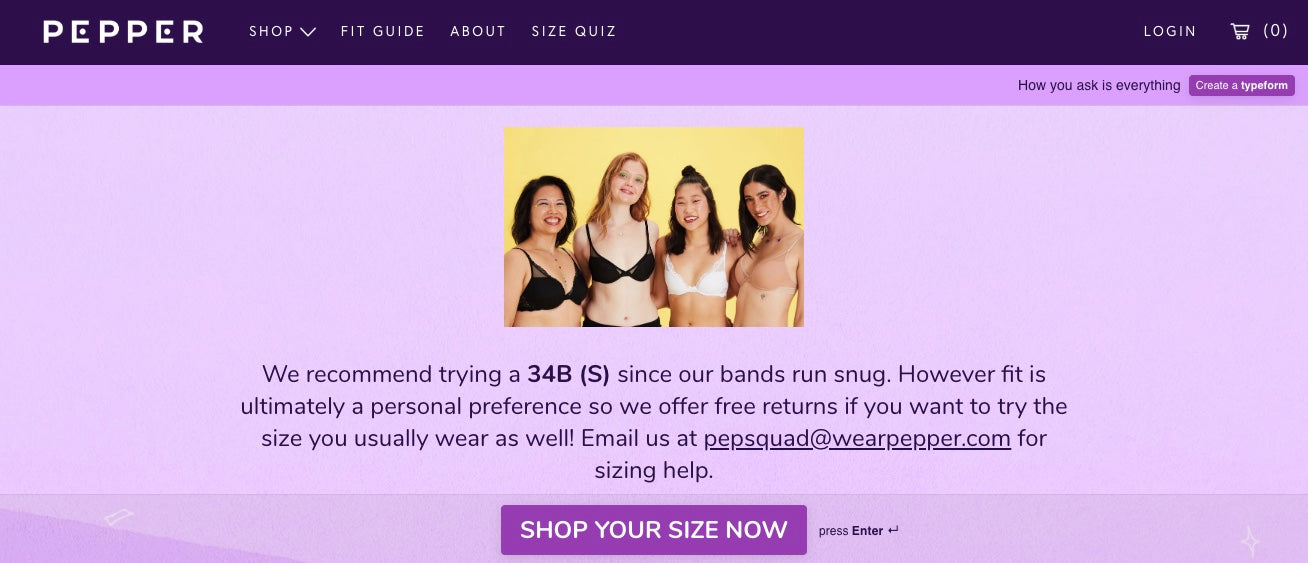
服装品牌之外,测验和自定义大小size charts can be helpful for any business selling products in multiple sizes or fits: dog collars, bikes, menstrual cups, child car seats, baby-wearing products, skis, and car roof racks are a few examples. Below we’ll demonstrate how quizzes can achieve other business goals, too.
Recommended tools:Kiwi Sizing,Visual Quiz Builder
2. Personalized product recommendations
Thinx, a contemporary brand in the feminine hygiene space, dares women to ditch disposable products in favor of its sustainable alternative: “period undies.” But wait, women havequestions. The brand understood early that addressing these would need to be part of the shopping journey, and their early no-bullshit ads were conversation-making.
But in 2019, Thinx upped the experience and combined education with product recommendations in an engaging way—a way that also shattered its conversion expectations. Brendan Hastings, Thinx’ vice president of engineering and digital product, spoke to us about the genesis of Know Your Flow, a quiz-style tool that collects customer information (number of period days, tampon usage, etc.) and outputs personalized recommendations.

Know Your Flow was created in response to the success of Thinx’ 2017 Fearless Bleeding Tour, which visited several US cities to host one-on-one concierge appointments with the brand’s “period specialist,” Dani Berkowitz. “She had literally a 100% conversion rate,” Brendan says. Though he recognizes that booking a period consultation is high intent, the brand was still blown away by the numbers—every person who received a personalized experience made a purchase. There was only one question to answer at the time: “How can we digitize Dani?”
At the launch of Know Your Flow, the conversion rate for quiz takers was five times higher than for those who did not start the quiz. And the tool had over a 90% completion rate. (With some tweaks to the tool, it’s now 99%.) On mobile, the results are even more impressive. “There we see seven times or eight times what our typical mobile conversion rate would be,” says Brendan. Based on the valuable data collected, the tool also continues to evolve and inform changes to other elements of the site.
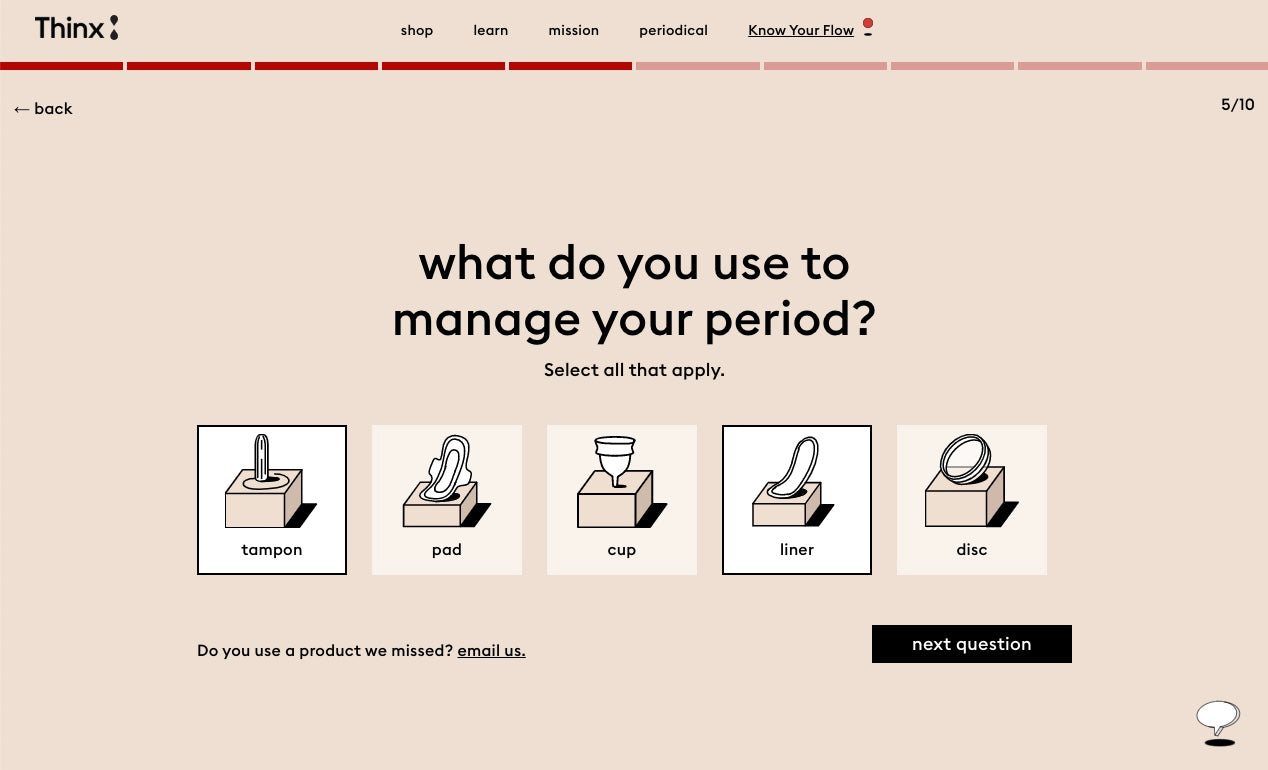
Legwear brandRacheluses a different method to guide visitors to purchase: an interactive AI style consultant. Though the principle is the same as a quiz—users input preferences and receive tailored recommendations—the format ischat-basedand replicates the experience of a personal stylist appointment.
See it in action:
Recommended tools:Limespot Personalizer,Visual Quiz Builder,Ombré AI Fashion Stylist
3. Customized experiences
Taryn Rodighiero launched her swimwear business,Kaikini, by sewing ready-made bikinis from her Hawaii studio. As with bras, swimwear fit is tricky—a size 8 swimsuit will fit my frame much differently than on another size 8 body. Taryn quickly recognized this challenge. While a fit quiz would help her customers select the best size or style for their bodies, she took the personalized experience one step further by adding custom-made swimwear to her lineup.
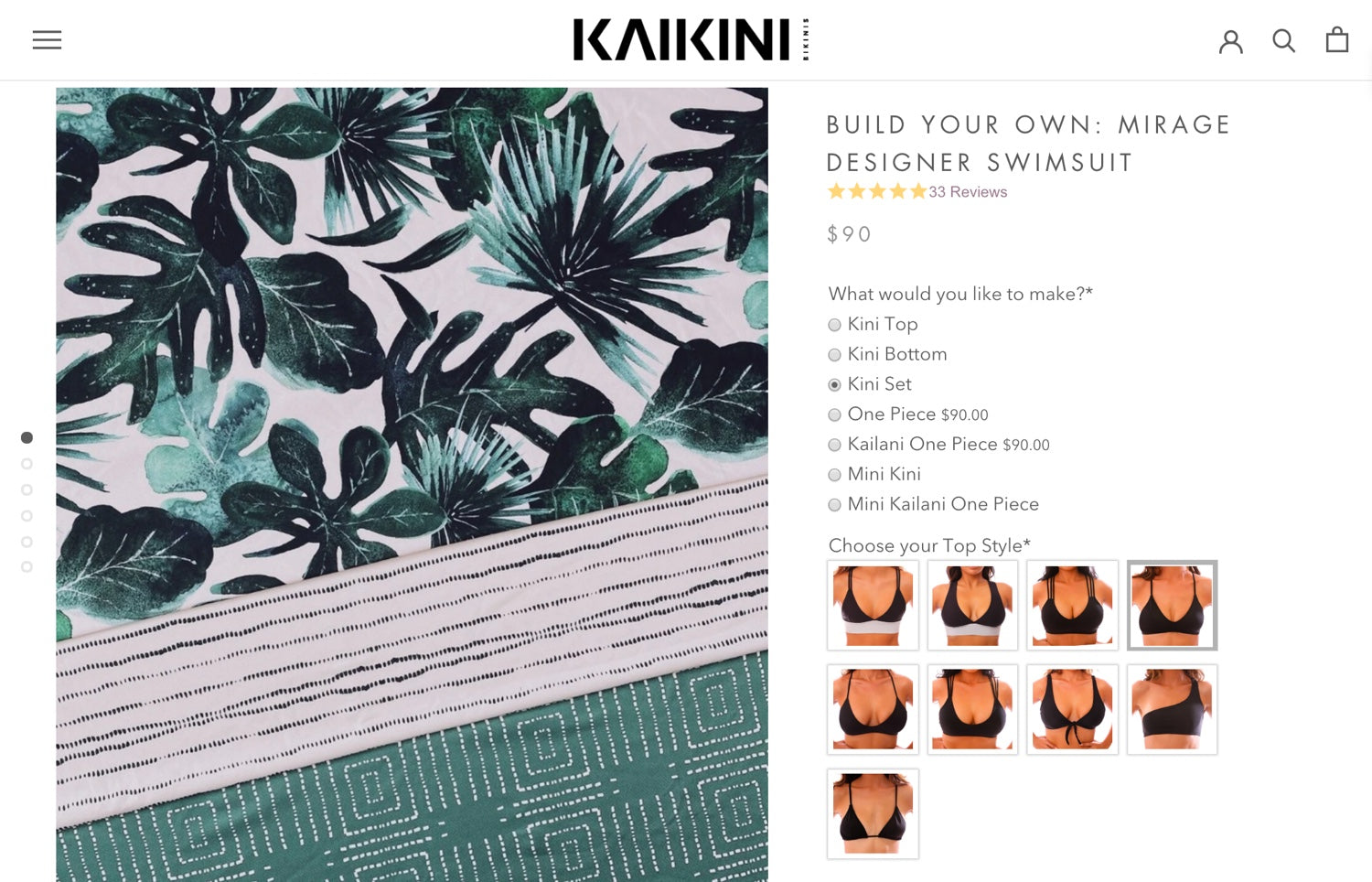
Customers can build suits by plugging in their own measurements and preferences (like more or less coverage). As her product is made to order, per each customer’s specifications, there is one concession: returns are not possible. Her concierge service, however, aims to minimize the need for returns altogether. “We make sure they are going to get a suit that fits right before we make it instead of after,” she says. And if it doesn’t fit perfectly? Alterations are free.
With purchases coming from all over the world, Taryn previously didn’t get much face time with her customers before offering custom suits. Her concierge service now allows her to build loyalty and gather feedback directly. “I personally love the face-to-face meetings,” she says. “Every time I speak to [my customers], I come away learning something new.”
Recommended tool:Bold Product Options
4. Smart, relevant reviews
The online beauty industry faces challenges similar to apparel, as there is increased likelihood of customers buying the wrong product—unique skin and hair characteristics, a multitude of skin tones, the variances in screens that make color hard to convey online. But many beauty brands have found clever ways to personalize the experience for each customer.
Beauty behemoth Sephora has used community,testimonials, and “smart reviews” to solve many of these challenges. Reviews contain user information (skin type, eye color) so buyers can filter reviews by others who have similar physical characteristics or beauty challenges. And users can even talk to each other via an on-site Conversations forum.
Like Sephora, Thinx reviews also contain helpful information about each reviewer—height, period management habits, size purchased—letting buyers hone in on the feedback that is most pertinent to them.
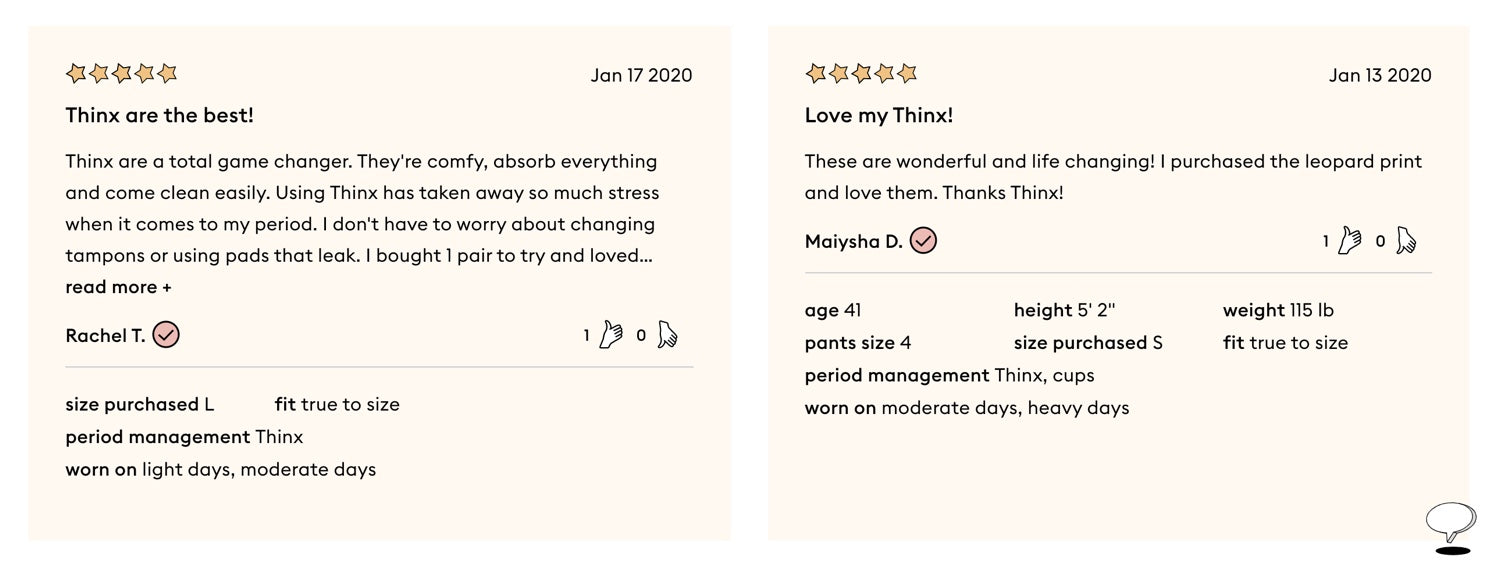
These extra helpful reviews not onlybuild trustwith a brand or product, they also build purchase confidence.
Recommended tool:Yotpo
5. Tailored product education
Kuldeep Knox developed her haircare line,Chāmpo, after pressing her Indian grandmother for her secrets to maintaining her thick hair. The line is based around Doshas, an Ayurvedic diagnosis system to determine hair type and, ultimately, the most suitable products for each. Education, then, is an essential part of the customer journey.
Rather than use FAQs or bombard customers with dense theory, Chāmpo’s website guides visitors through a hair quiz that determines one’s Dosha. The results then deliver only the information—and product recommendations—pertinent to that customer. Not only does the quiz benefit the customer, it also keeps Chāmpo continually up to date on customer needs. “We continuously gather data, seek out feedback, and act upon it to keep improving and keep our brand evolving,” says Kuldeep.
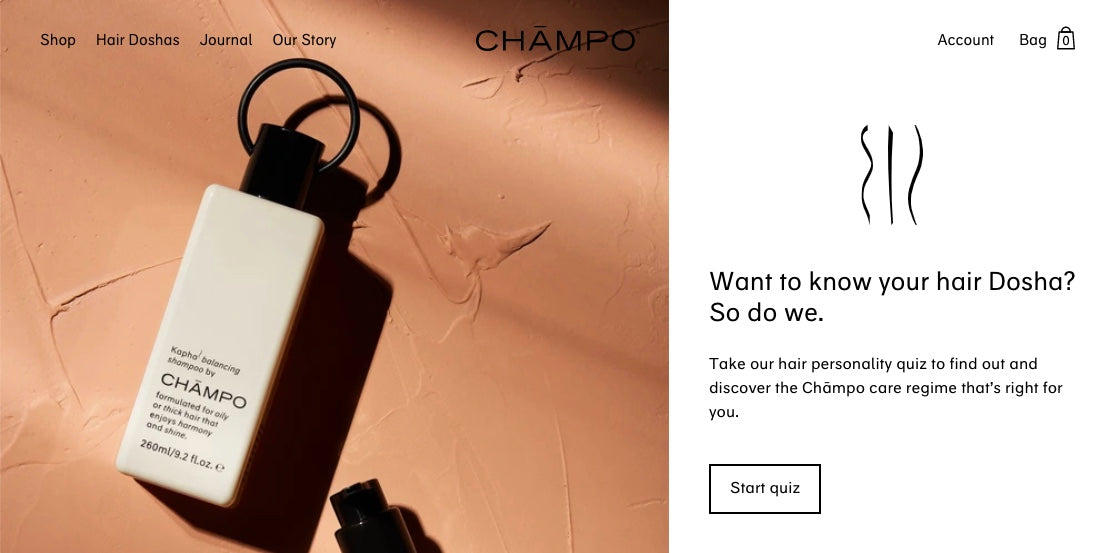

Thinx also builds education into its tool, guiding customers while simultaneously learning about their needs. Arguably the most brilliant part of Know Your Flow is the resulting “Your Period Journey.” Thinx breaks down your answers into a smart data visualization of the arc of your period and the products you normally consume. Insights from the live tour indicated that most women didn’t really think about these things. “They had the information, but they were on autopilot,” says Brendan.
But why is this information so critical? Thinx underwear starts at $24 and can run up to $42 per pair. Contrasting the price with a customer’s total spend on tampons or pads helps to justify the upfront cost. This page also calculates the number of plastic disposables that won’t be hitting landfills because you switched to their product. Good enough for me!
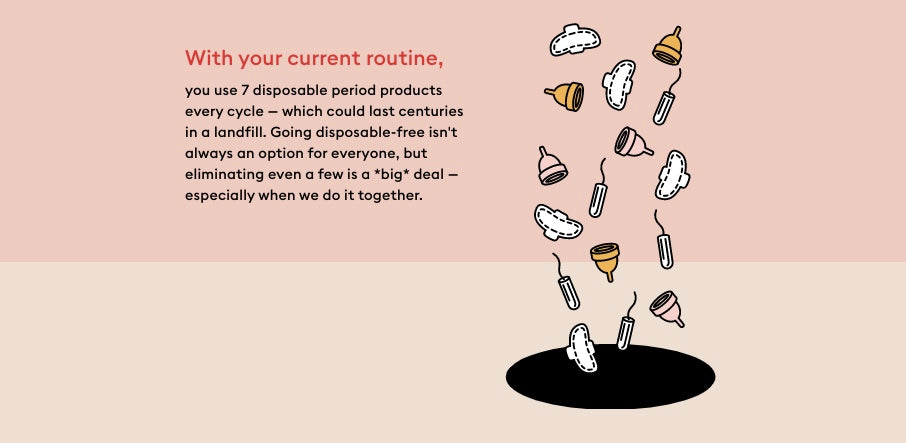
Recommended tool:Visual Quiz Builder
6. Mirroring the in-store experience online
The arguments are compelling for personalization when it comes to a brand like Thinx that’s so, well,personal. But outside of fashion and beauty, other retailers are employing the power of personalized experiences. One example can be found within the home décor and electronics industries, where interest in immersive technology (thinkaugmented reality) has seenan uptick.
In New York, Brooklyn Bicycle Co.’s showroom is designed to be “transformational, not transactional,” says founder Ryan Zagata. The brand has invested in the space in a way that distances it from typical bike shops, where the purchase experience can be intimidating. The coffee is hot, staffers are conversational—not salesy—and the bikes are meant to be touched and taken for a spin.
We learn about the wants and desires of the people who are interested in our brand and that really helped us refine our sales process.
The approach for the brick-and-mortar business has paid off. “We realized that every guest that walked in through these doors was a win for us,” says Ryan. “We learn about the wants and desires of the people who are interested in our brand and that really helped us refine our sales process.” As the brand grew its online D2C business, Ryan and his team wanted a way to bring the in-store experience to customers outside of New York.
When Brooklyn Bicycle Co. introduced a simple quiz to the purchase flow, they saw a spike in conversion rate. “It’s a low commitment for people to get them into our funnel,” says Ryan. “And people who go through the bike finder app are much more likely to buy.” This is no anomaly:one reportfinds that across the board interactive content converts at twice the rate of passive content.
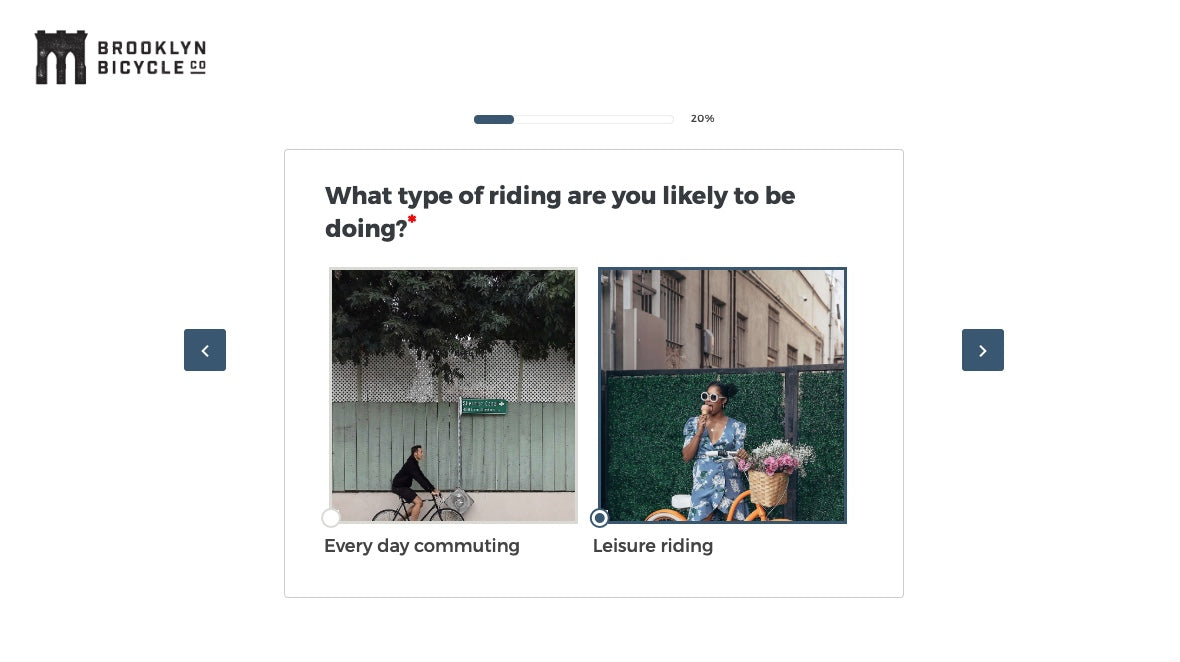
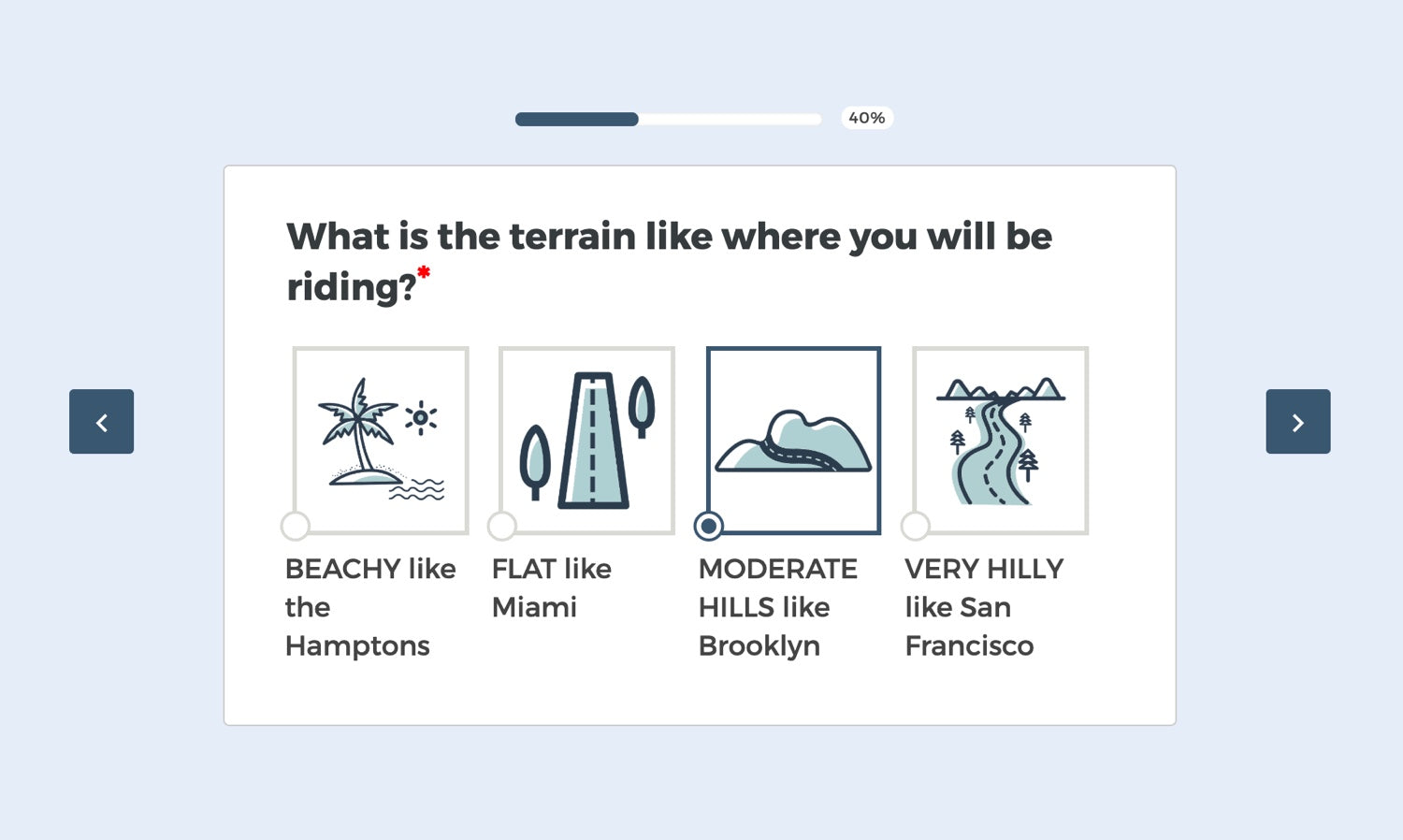
Ryan says that 21% of Brooklyn Bicycle Co. quiz takers become valuable leads, too (they provide their email at the end of the quiz). The brand has another chance to convert those leads by following up with an invitation to visit in person or book a concierge appointment.

To further replicate the human-to-human experience of the showroom, the free concierge service (it may be a chat or video call) is designed to answer questions and understand customer needs. These touchpoints tell the team a lot about their potential customers. It’s valuable data that informs how they’ll invest their efforts—like where to build more partnerships.
The brand partners with 450 physical bike shops, where the products are shipped and assembled for online customers, facilitating a face-to-face experience. “If something were to go wrong with the bike,” says Ryan, “you have a local place that you have a relationship with that can address any issues.”
Recommended tools:Shopify AR,Octane
7. Closing the personalization loop: returns
In 2019, online shoppers spentmore than $620 billionon fashion and beauty. That’s a lot of product going out, but what’s coming back? The return rate for clothing and shoes bought online isestimated at 30%-40%, according to one expert, while the rate across all industries isonly 20%.
But returns happen. Even with the extra measures taken to match the right product to the right buyer. Having a simple and friendly returns process is therefore an important part of closing the loop on the personalized experience. A painless returns experience drives loyalty, saysone study: 95% of respondents said they would shop at a retailer again after having a positive returns experience.
Some apps, like Return Magic, give your customers more ownership over the returns process and tailor each experience with smart rules.
Recommended tools:Return Magic,Returnly
Quiz: What personalization tools are right for your business?
We’ve shared a lot about the largely untapped potential of personalized shopping experiences and bespoke recommendations. Now, we’re putting a few of those ideas into practice. Take our quiz below to receive a tailored recommendation for你的业务。personalizati个性化工具on tools. How meta.
Feature illustration by Rose Wong

